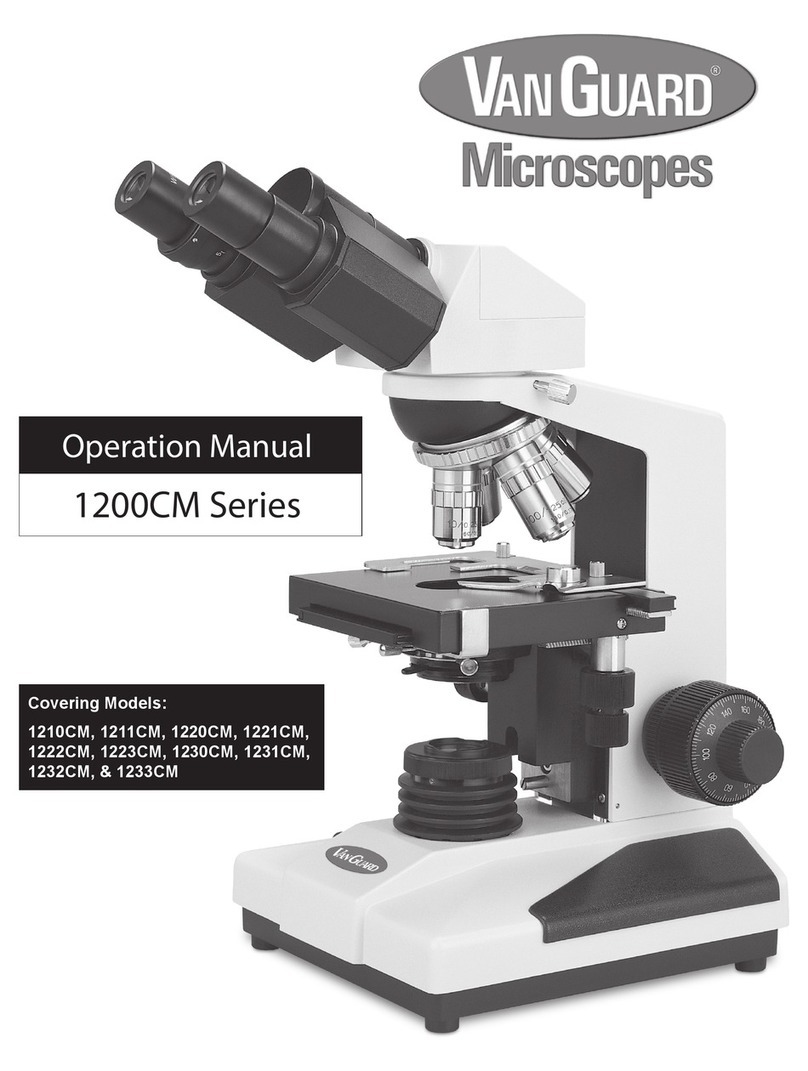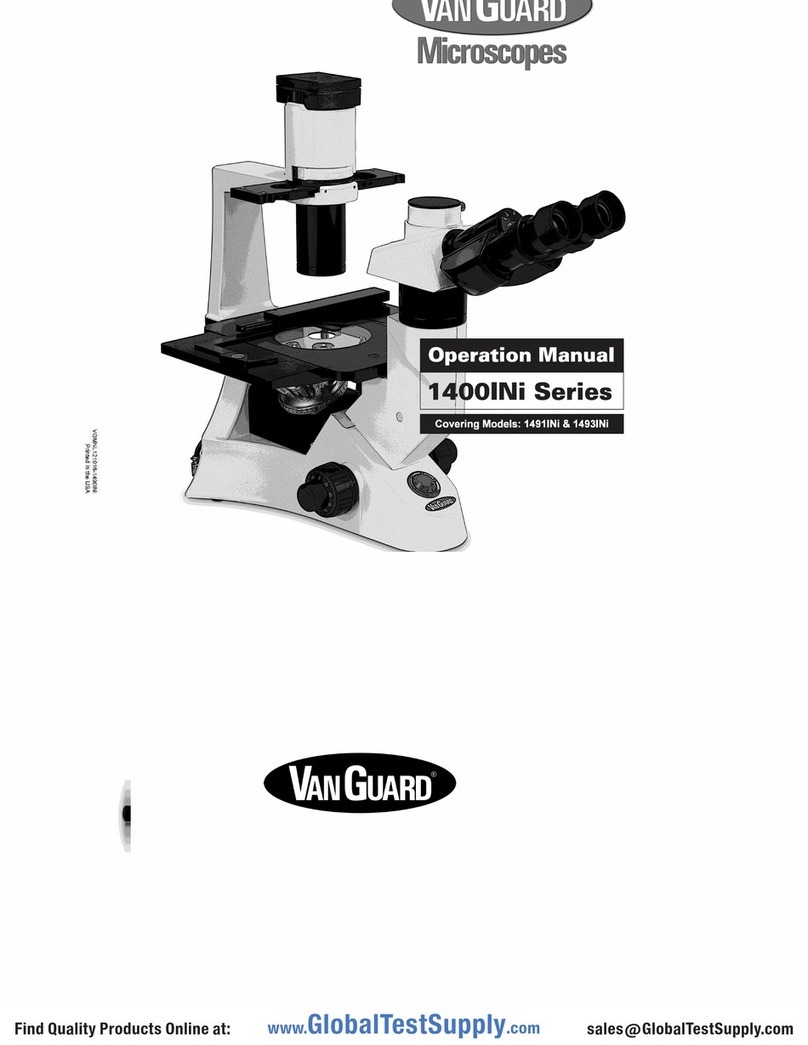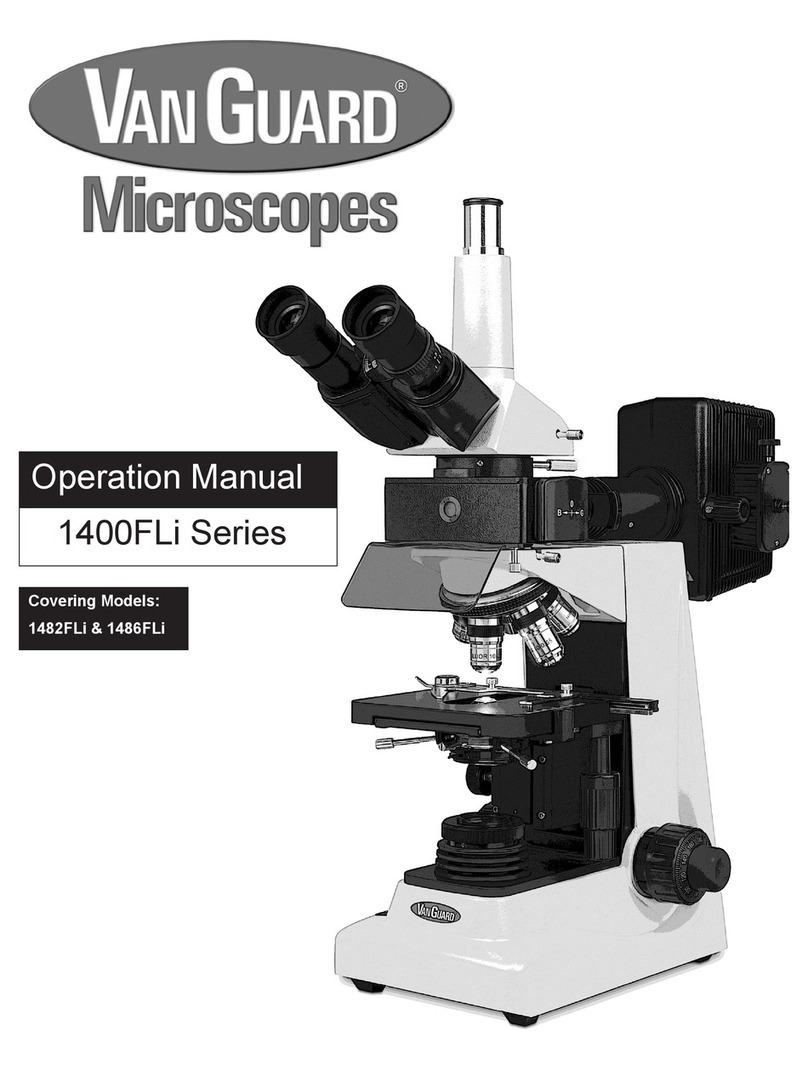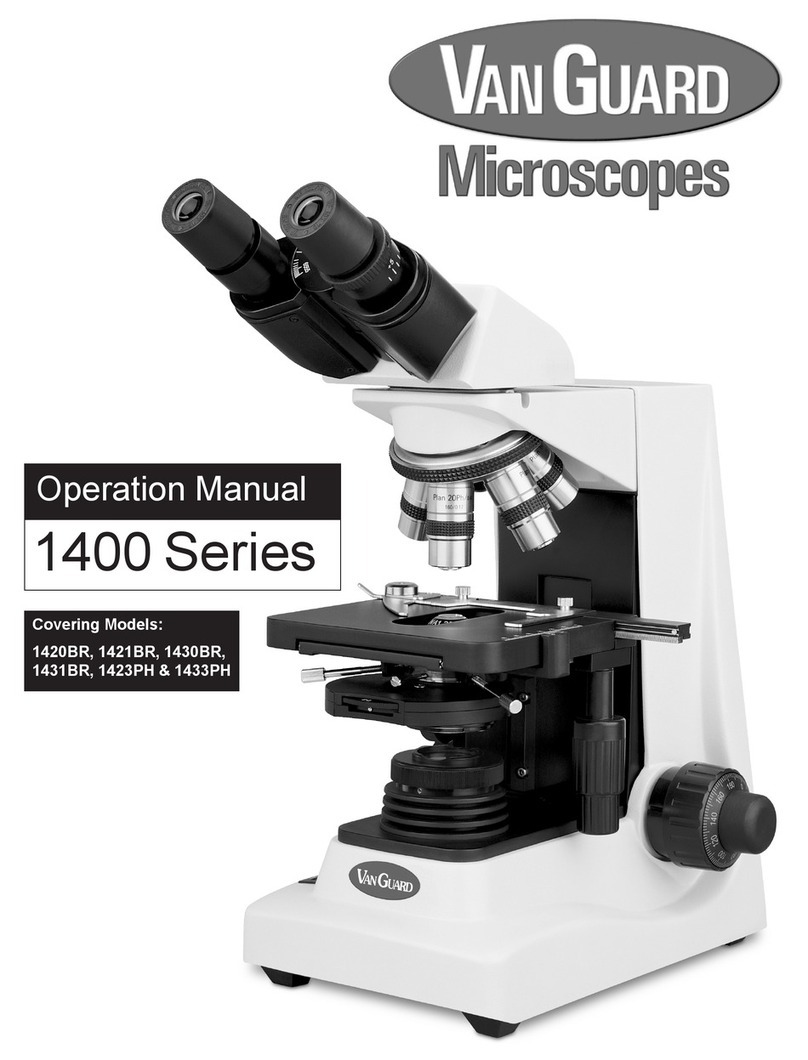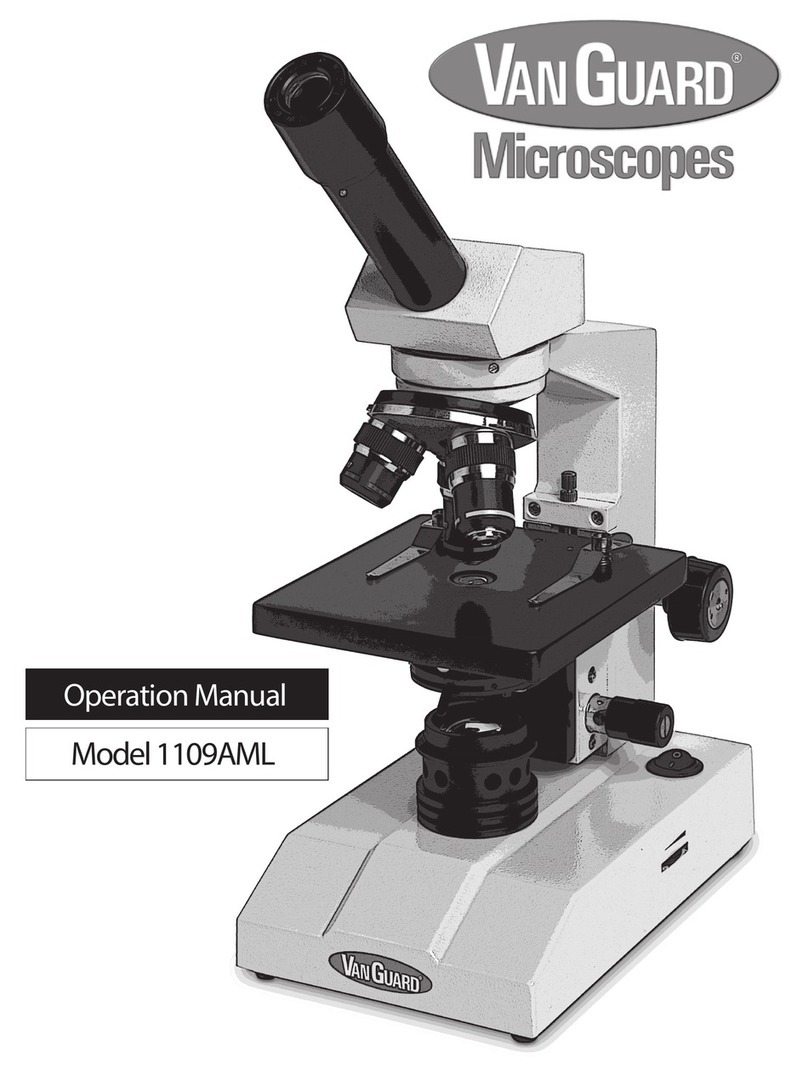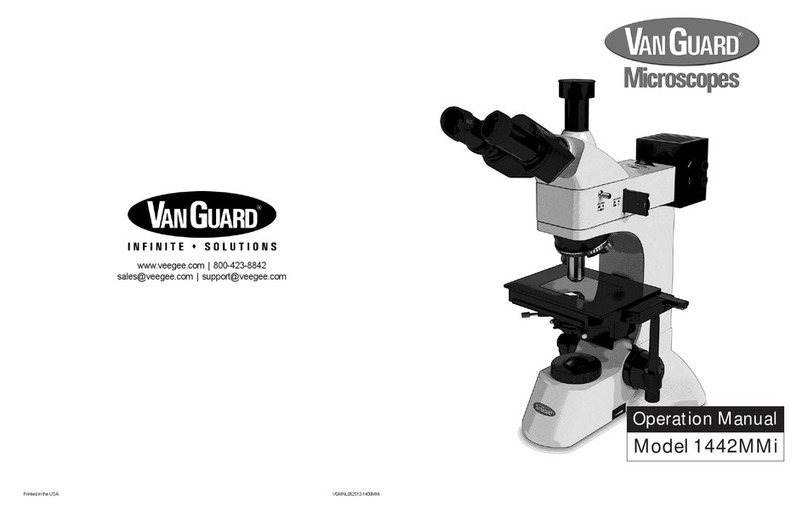
Fine tuning can be done by opening the aperture iris diaphragm until the light field almost fills the entire field. If what is
seen through the eyepieces resembles Figure 1C, alternately rotate the aperture iris diaphragm centering knobs until
the light field is centered as in Figure 1D. The upper illumination is now properly centered.
For normal operation, the filterwheel should be set so that the dispersion (frosted) filter is in the light path. This
filter disperses the light for much more even illumination across the field of view. The colored filters are often used when
applications or samples call for color contrasting.
The field iris diaphragm may need to be closed down to induce additional contrast onto a specimen. This is often
necessary, depending on the sample, for the higher power objectives.
For polarized light, push in the right side (blue) polarizerslider. Slide the polarizinganalyzer to the fully up position. When
the polarizing analyzer is slid into position, the overall field of view should take on a much darker color. Certain colors/
shapes should brighten and contrast significantly against the darker field. Polarized light can be very useful for detecting
inconsistencies or defects on metal parts, circuit boards, wafers, etc.
General Operation
5
6
7
8
Substage(Lower)Illumination[MODEL1242MMONLY]
Connect the power cord to a suitable power supply; turn on the substage illuminator with the ON/OFF power switch
located on the lower left side of the instrument. If light does not come on, check to see that the variableilluminationcontrol,
located on the lower left side of the instrument, is on the highest setting.
zVerify that the left side (white) polarizer slider is pushed in.
zRotate the nosepiece until the 10X objectiveis in the light path.
zRaise the substage assembly fully by turning the substage adjustment knob counter-clockwise.
zOpen the aperature irisdiaphragm to the largest setting by using the aperature iris diaphragm adjustment lever which
extends from the condenser assembly.
zWhile looking into the microscope eyepieces, close the field iris diaphragm to the smallest setting by turning the
uppermost section of the substage illuminator counter-clockwise.
zClosing the iris in this manner will reduce the field so that a small white hexagon is visible within a black field (see Figure
1A). Focusing of the hexagon is performed by turning the coarse/finefocuscontrols. This white hexagon is the light which
is passing through the field iris and should be centered in the black field. If not, move it to the center (see Figure 1B) by
tightening and/or loosening the condensercentering knobs.
Fine tuning can be done by opening the fieldiris diaphragm until the white hexagon almost fills the entire field (see Figure
1C), and then readjusting (see Figure 1D).After centering the condenser open the field iris diaphragm slightly wider than the
field of view.
For polarized light, push in the right side (blue) polarizerslider. Place the included substagepolarizing analyzer on top of
the field iris diaphragm. Rotate the polarizing analyzer until the overall field of view takes on a much darker color. Certain
colors/shapes should brighten and contrast significantly against the darker field.
4
1
2
3
4
Interpupillary and Diopter Adjustment
Interpupillary adjustment (the distance between eyepieces) is made through a “folding” action. This Seidentopf design
allows for a folding adjustment which is quickly and easily done for each user.
Diopter adjustment allows for proper optical correction based on each individual’s eyesight. This adjustment is easily
made and is recommended prior to each use by different users to prevent eyestrain.
Using the 40X objectiveand a sample slide (i.e. one with an easily focusable image), close your left eye and bring the image
into focus in your right eye with the coarse/fine focus control. Once the image is well-focused using only your right eye,
close your right eye and check the focus with your left. If the image is not perfectly focused, make fine adjustments with the
diopter adjustment mechanism located on the left eyetube. Once complete, the microscope is corrected for your vision.
1
2
3
General Operation
Lamp Replacement (Upper Illuminator)
Before attempting to replace or remove the lamp, UNPLUG THE MICROSCOPE FROM ANY POWER SOURCE.
Remove the illuminator door by loosening the set screw and gently lifting the door up and outwards. The lamp can now be
removed simply by grasping the lamp and pulling it from its socket. When replacing, insert the new lamp into the same socket.
In addition, be careful not to touch the glass lamp envelope when replacing—use a tissue or other medium to grasp the lamp.
This will prevent the oils from your hand from reducing the lamp life. Reattach the illuminator door to the upper illuminator
housing . Be sure to center the lamp by following steps 1-5 on pages 3-4.
5
1
2
Focusing and Mechanical Stage Mechanisms
Focus the image by turning the coarse/fine focus control knobs. The large knob is used for coarse adjustment, while the
smaller knob is used for fine adjustment. The coaxial arrangement allows for easy, precise adjustment without stage drift.
Turning the coarse/finefocuscontrolwill raise and lower the stagevertically. One complete turn of the fine focusing knob
will raise or lower the stage0.3mm; the smallest graduation refers to 2μm of vertical movement. One complete turn of the
coarse focusing knob will raise or lower the stage3.6mm. To ensure long life, always turn the focusing knobs slowly and
uniformly.
The focusing tension control knob is located just inside of the left-hand focus control knob. For tighter tension, turn the
control knob in a clockwise motion. For looser tension, turn the control knob in a counterclockwise motion.
The up-stop mechanism is located just inside of the right-hand focus control knob. It allows the user to set a maximum
point to which the stagecan be raised to prevent damage to the objective and specimen. To set this point, turn the up-stop
mechanism in a counterclockwise motion, so that its tab is facing down. Raise or lower the stage, by turning the focus
control knobs, to the desired height. Once acheived, turn the up-stop mechanism in a clockwise motion, so that its tab is
facing up. Once gently tightened, the up-stop mechanism will not allow the stage to be raised higher than the set point.
The mechanical stage X-Y controls provide easy and accurate positioning of the sample. One complete turn of the
latitudinal (Y) control will move the specimen 34mm. One complete turn of the transverse (X) control will move the
specimen 20mm.
1
2
3
4
5
Figure 1A Figure 1B Figure 1C Figure 1D
